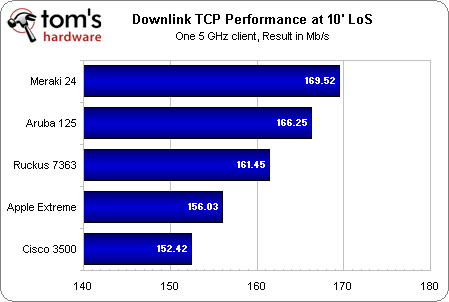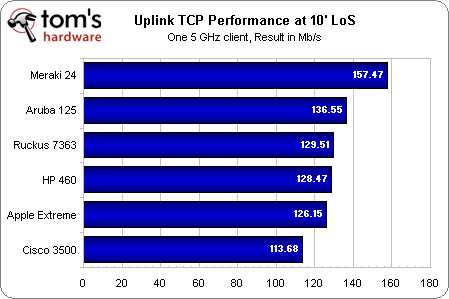Why Your Wi-Fi Sucks And How It Can Be Helped, Part 2
In Part 1, we explained what can go wrong with Wi-Fi signals and how access points can work to improve your wireless performance. It's time for a reality check. We throw six contenders against 65 clients and some hellish interference. Who's left standing?
Benchmark Results: Close Range, No Interference

We begin with the single-client downlink test at 5 GHz with a 10-foot line-of-sight distance. HP handily trounces the field here, thanks to its triple-stream capability. Given that, it’s not surprising that Meraki comes in second place. These are the only two APs able to leverage all three of the client’s potential streams.

In the 10-foot uplink test, Meraki soars out to 157 Mb/s, leaving the next four contenders clustered around 130 Mb/s and Cisco bringing up the rear at 114 Mb/s. Why would the triple-stream HP fall back into the pack here? We don’t have a good explanation. Theoretically, it should have done better. Our only explanation would be that perhaps HP has a somewhat asymmetrical orientation in its omnidirectional antennas. This might explain the lag we see, as well as the jump witnessed on the next page—if the client happened to fall in a sweet spot for that AP’s signal.
After all of the many optimizations we discussed in part 1, why doesn’t Ruckus sweep the field and win here? Because in all wireless approaches, there are compromises. Ruckus APs are designed for adaptability. Keep in mind that the AP being tested doesn’t know its distance from the client. It only senses signal strength. So, if an AP is programmed to keep continually searching for a better pattern, it’s going to spend resources essentially saying, “Can I hear you better this way? Nope, so I’ll go back to how I was. Well, how about this way? Nope, back again. How about...?” At such close range, there’s only one best path: direct line-of-sight. Attempting to optimize to anything else is only going to hamper performance, but Ruckus keeps trying. That’s the trade-off. Additionally, the benefits of single-antenna beamforming and signal steering vanish in such close quarters.
Stay On the Cutting Edge: Get the Tom's Hardware Newsletter
Get Tom's Hardware's best news and in-depth reviews, straight to your inbox.
Current page: Benchmark Results: Close Range, No Interference
Prev Page Coverage Areas Next Page Benchmark Results: Mid-Range, No Interference-
winner4455 Hey, I still haven't read this article but right away I notice the new format. Just thanking you for listening to your readers! :)Reply -
cangelini Very welcome Winner. We thought the picture story format would work for that last part and didn't realize the text would come out to be so terrible. From now on, we'll only use picture stories when the captions fit without requiring another click!Reply -
tacoslave cangeliniVery welcome Winner. We thought the picture story format would work for that last part and didn't realize the text would come out to be so terrible. From now on, we'll only use picture stories when the captions fit without requiring another click!"Now thats what i like to hear!"Reply -
nekromobo What if you add few thin-foil balls to room (the size of fist or 2)Reply
That should add few rf-reflections or paths, right?
Just your 2cent amplifier.. :) -
I wonder why you didn't include Juniper products (formerly trapeze)to this test. It's quit a big player here in europe. Trapeze also produced the 3com wireless manager and accesspoints which was sold widely here.Reply
-
Hupiscratch In the page "Benchmark Results: Close Range, No Interference", the HP AP is missing on the downlink graph.Reply -
Onus This was an outstanding article. Going just by this, Ruckus and Cisco are the only two I'd consider out of the box, but it would be very interesting to do a follow on that features even a minimal amount of tweaking to see what changes. A consumer expects a product to work well out of the box, but an enterprise network engineer almost certainly does not.Reply
-
Very thorough. Lots of hard work went into this and it shows. But how did you select client devices? Did you try any other chipsets? We tried something like this with more diverse clients and got results that were too variable to reach conclusions. (Some clients just did better with some APs than others.)Reply